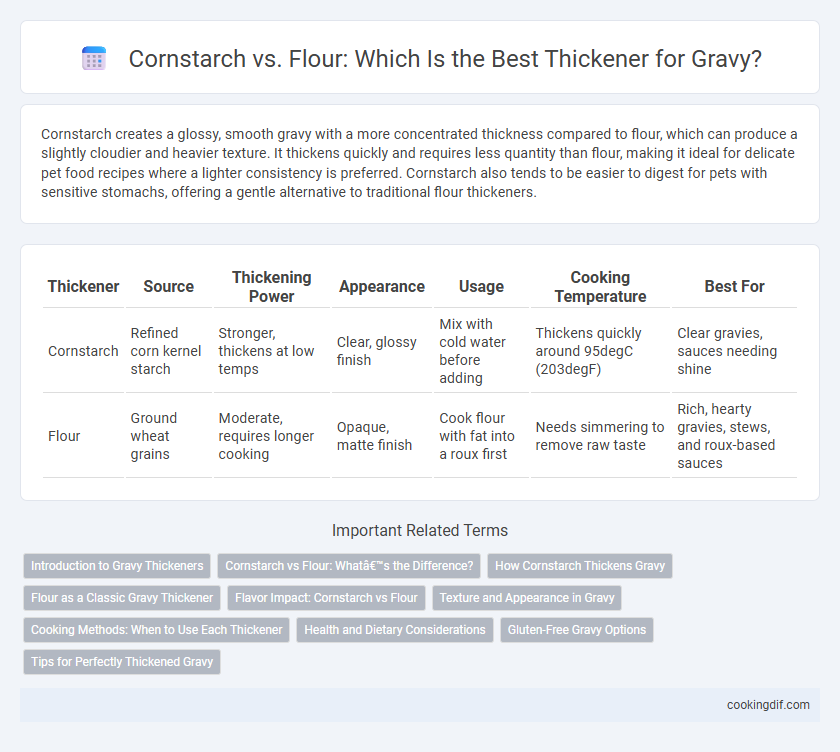Cornstarch creates a glossy, smooth gravy with a more concentrated thickness compared to flour, which can produce a slightly cloudier and heavier texture. It thickens quickly and requires less quantity than flour, making it ideal for delicate pet food recipes where a lighter consistency is preferred. Cornstarch also tends to be easier to digest for pets with sensitive stomachs, offering a gentle alternative to traditional flour thickeners.
Table of Comparison
| Thickener | Source | Thickening Power | Appearance | Usage | Cooking Temperature | Best For |
|---|---|---|---|---|---|---|
| Cornstarch | Refined corn kernel starch | Stronger, thickens at low temps | Clear, glossy finish | Mix with cold water before adding | Thickens quickly around 95degC (203degF) | Clear gravies, sauces needing shine |
| Flour | Ground wheat grains | Moderate, requires longer cooking | Opaque, matte finish | Cook flour with fat into a roux first | Needs simmering to remove raw taste | Rich, hearty gravies, stews, and roux-based sauces |
Introduction to Gravy Thickeners
Gravy thickeners such as cornstarch and flour play essential roles in achieving the desired consistency and texture. Cornstarch offers a smooth, glossy finish and thickens quickly at lower temperatures, making it ideal for clear gravies. Flour provides a richer, more opaque texture with a slightly nutty flavor, requiring longer cooking to eliminate its raw taste.
Cornstarch vs Flour: What’s the Difference?
Cornstarch and flour differ significantly as thickeners in gravy; cornstarch offers a smoother, clearer finish and requires less quantity than flour to achieve the same thickness. Unlike flour, which can impart a slightly opaque and pasty texture, cornstarch thickens quickly when mixed with cold water and heated, making it ideal for glossy gravies. However, flour provides a more stable, hearty base that withstands longer cooking times without breaking down, making it a preferred choice for slow-simmered gravies.
How Cornstarch Thickens Gravy
Cornstarch thickens gravy by absorbing water and swelling when heated, creating a glossy and smooth texture with greater clarity compared to flour. It requires a slurry made of cornstarch and cold water before adding to hot liquid to prevent lumps and ensure even thickening. Cornstarch has twice the thickening power of flour, allowing for a lighter, more translucent gravy without the flour's potential pasty flavor or dull appearance.
Flour as a Classic Gravy Thickener
Flour remains the classic thickener for gravy due to its ability to create a rich, velvety texture and deepen flavor complexity. When cooked properly, flour develops a nutty aroma that enhances savory dishes while providing a stable, glossy consistency. Its widespread availability and traditional use in sauces make it a reliable choice for achieving the perfect gravy thickness.
Flavor Impact: Cornstarch vs Flour
Cornstarch creates a glossy, smooth texture in gravy with a neutral flavor that allows the natural taste of the dish to shine through. Flour imparts a slightly nutty, toasted flavor that enriches the gravy's complexity but can sometimes mask subtle seasoning. Choosing cornstarch preserves a cleaner, lighter flavor profile, while flour adds depth and a richer, more traditional taste.
Texture and Appearance in Gravy
Cornstarch creates a glossy, smooth texture in gravy with a translucent appearance, enhancing its visual appeal and providing a silky mouthfeel. Flour-based gravy tends to be more opaque and has a creamier, denser texture due to its starch granules and protein content. The choice between cornstarch and flour significantly impacts the final consistency and look, with cornstarch delivering a lighter, clearer gravy and flour producing a richer, more robust sauce.
Cooking Methods: When to Use Each Thickener
Cornstarch is ideal for thickening gravies at the end of cooking due to its fast-acting properties and ability to create a glossy, translucent finish without altering flavor. Flour requires a longer cooking time to eliminate its raw taste and is best used early in the cooking process, often as a roux, to develop deeper flavor and a matte texture. For gravies simmered over extended periods, flour provides stability, while cornstarch excels in quick-thickened sauces served immediately.
Health and Dietary Considerations
Cornstarch offers a gluten-free alternative to flour, making it suitable for individuals with celiac disease or gluten sensitivity. It has fewer calories and carbohydrates per serving compared to flour, which can benefit those managing their weight or blood sugar levels. However, cornstarch provides minimal fiber and protein, so it may be less nutritionally balanced than whole grain flours for thickening gravies.
Gluten-Free Gravy Options
Cornstarch is a popular gluten-free thickening agent for gravy, offering a smooth, clear finish and a neutral flavor that enhances the dish without altering taste. Flour-based gravies often contain gluten, making cornstarch an ideal alternative for those with gluten sensitivities or celiac disease. Using cornstarch requires mixing it with cold water before adding to hot liquids to prevent clumping and achieve a consistent texture.
Tips for Perfectly Thickened Gravy
Use cornstarch for a clear, glossy gravy with a smooth texture, mixing it with cold water before adding to hot liquid to avoid lumps. Choose flour for a richer, more opaque gravy with a slightly nutty flavor, cooking it longer to eliminate raw taste and achieve the desired thickness. Adjust the amount incrementally and whisk continuously to ensure a perfectly thickened gravy that coats the back of a spoon without clumping.
Cornstarch vs flour for thickener Infographic

 cookingdif.com
cookingdif.com